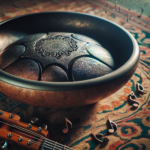The handpan is a unique and entrancing musical instrument known for its ethereal sound and the emotional depth it can convey. Invented in the early 2000s, the handpan quickly garnered a passionate following. One of the most inspiring aspects of this instrument is its ability to evoke a wide spectrum of emotions through different scales. Each scale has its own distinct sound and energy, which can influence the emotional state of both the player and the listener. In this article, we will delve into the emotional resonance of different handpan scales, exploring why they evoke particular feelings and providing insight into their potential uses.
Understanding Handpan Scales
Handpans are typically tuned to specific scales, each with its own note layout and sonic characteristics. These scales are often derived from various cultural musical traditions, and they can range from major and minor scales to more exotic and unique tunings. The layout of the notes on a handpan and the chosen scale play a significant role in determining the instrument’s overall sound and emotional impact.
Common Handpan Scales and Their Emotional Resonance
1. D Minor Scale
The D Minor scale is one of the most popular scales for handpans. Often referred to as the “Celtic Minor,” this scale has a haunting and melancholic feel. The D Minor scale is known for evoking deep emotions, introspection, and a sense of longing. It resonates with feelings of sadness and beauty, making it a perfect choice for contemplative and meditative music. This scale is ideal for solo performances where the intent is to create an intimate and reflective atmosphere.
2. C# Minor Scale
The C# Minor scale provides a slightly brighter but still deeply emotional tone. It carries a sense of mystery and intrigue. This scale can invoke feelings of yearning and introspection, but it also has an underlying warmth that can bring comfort. Musicians often choose the C# Minor scale for storytelling through music, as it enables the creation of evocative and dynamic musical narratives.
3. D Major Scale
The D Major scale brings a more uplifting and joyous sound compared to its minor counterpart. It exudes optimism, happiness, and a sense of celebration. This scale is often used to create lively and cheerful music, making it perfect for social gatherings and communal playing. The D Major scale can uplift the spirit and brighten the mood of anyone listening, making it an ideal choice for positive, energetic performances.
4. Ake Bono Scale
This scale originates from Japanese musical traditions and has a distinctively tranquil and calming effect. The Ake Bono scale is known for its meditative quality, often used in therapeutic contexts to promote relaxation and stress relief. The notes in this scale create a smooth, flowing sound that helps soothe the mind and create a peaceful atmosphere. The Ake Bono scale is perfect for creating ambient music that aims to provide a sense of serenity and mindfulness.
5. Integral Scale
The Integral scale, also known as the “Integral Hang Scale,” has a very balanced and harmonious sound. Its versatility allows the player to explore a wide range of emotions, from joy and contentment to melancholy and introspection. This scale is often used in compositions that require a dynamic emotional journey, as it provides the flexibility to express complex and shifting feelings. The Integral scale is a go-to for musicians seeking a well-rounded scale that can adapt to various musical styles and moods.
6. Kurd Scale
The Kurd scale is known for its rich and deep sound, often associated with Middle Eastern music. This scale has a mystical and introspective quality, evoking feelings of ancient wisdom and spiritual connection. The Kurd scale is suitable for creating music that transports listeners to a different time and place, offering a profound emotional experience. Its exotic sound makes it a favorite for those looking to explore more adventurous and evocative musical landscapes.
The Role of Timbral Qualities
Beyond the scale itself, the timbral qualities of the handpan can significantly influence its emotional resonance. Factors such as the material of the handpan, its construction, and the skill of the maker all contribute to its unique sound. High-quality handpans produce rich overtones and a balanced resonance that enhance the emotional depth of the music. The way a player strikes the handpan, using techniques like finger rolls, slaps, and muting, can further shape the emotional impact of the performance.
Connecting with the Audience
A key aspect of playing handpan music is the connection between the performer and the audience. The emotional resonance of different scales allows musicians to communicate their inner feelings and create a shared emotional experience. By choosing the right scale and playing with intention, handpan players can craft performances that resonate deeply with their listeners. Whether aiming to soothe, uplift, or introspect, the emotional language of handpan music is a powerful tool for connection.
Applications of Handpan Music
The emotional resonance of different handpan scales makes the instrument suitable for a wide range of applications. In therapeutic settings, handpan music is used for its calming and healing properties. The soothing sounds of scales like the Ake Bono can help reduce stress and anxiety, promoting relaxation and well-being. In educational contexts, the handpan serves as a tool for teaching musical concepts and emotional expression. Schools and music programs incorporate the handpan to foster creativity and emotional intelligence among students.
Handpan music also plays a role in spiritual practices and meditation. The instrument’s ethereal tones and resonant scales create an atmosphere conducive to mindfulness and inner exploration. Practitioners use handpan music to enhance meditative states, facilitating deeper contemplation and spiritual connection. The handpan’s ability to tap into a wide range of emotions makes it a valuable asset in various artistic and creative endeavors, from dance and theatre to film scoring and sound healing.
Conclusion
The handpan is a remarkable instrument with the ability to convey a vast array of emotions through its different scales. From the melancholic beauty of the D Minor scale to the uplifting joy of the D Major scale, each tuning offers a unique emotional experience. The versatility and expressive power of handpan music make it a compelling choice for musicians, therapists, educators, and spiritual practitioners alike. As players continue to explore the emotional landscapes of different scales, the handpan will undoubtedly remain a source of inspiration and connection for many years to come.
FAQs
1. What is the best scale for beginners to start with?
For beginners, the D Minor scale is often recommended due to its popularity and accessibility. This scale provides a balanced, melodious sound that is easy to play and suitable for a variety of musical styles.
2. How do I choose the right scale for my emotional expression?
Choosing the right scale involves understanding the emotional characteristics of each scale and considering the feelings you wish to convey. Experiment with different scales and pay attention to how each one makes you feel to find the best match for your expression.
3. Can handpan music help with stress and anxiety?
Yes, handpan music is often used in therapeutic settings for its calming and soothing qualities. Scales such as the Ake Bono are particularly effective in promoting relaxation and reducing stress and anxiety.
4. Is the handpan suitable for group performances?
Absolutely. Scales like D Major, with their uplifting and joyous sounds, are perfect for group performances and communal playing. The handpan’s harmonious tones can create a cohesive and enjoyable musical experience for participants.
5. Where can I learn to play the handpan?
You can learn to play the handpan through various online resources, tutorials, and instructional videos. Additionally, workshops and classes led by experienced handpan players can provide hands-on guidance and personalized instruction.





